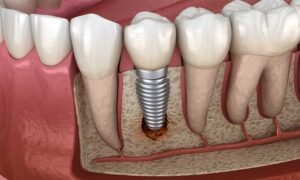Book a dental appointment
Planning treatment
Planning treatment
After a tooth is extracted, the bone ridge begins to change and often its dimensions shrink. These processes may worsen the conditions for placing an implant in future. If removed teeth are not replaced for a longer period, the teeth adjacent to the edentulous area may begin shifting from their position and the teeth on the opposite jaw may get out slightly in a search of opposite teeth. These processes may cause a situation where not enough space is left to insert an implant and place a crown on it.

To prevent such changes that complicate replacing teeth, necessary procedures to compensate or avoid long-term complications that are associated with the removal of a tooth should be planned already before extracting the tooth with a hopeless prognosis.
Alveoli/ridge preservation: this is the simplest procedure to compensate resorption of bone tissue after tooth extraction. Extraction wound can be filled in with various bone replacement materials, collagen and, if necessary, covered with connective tissue transplant. There are many options available and the chosen procedure depends on the state of the extraction wound, the patient and the price-benefit ratio. The bone related to the tooth will be absorbed in any case but this procedure helps to preserve the dimensions of the ridge that are necessary for the placement of an implant and achieving a natural result. This procedure will help reduce extensive bone restoration procedures and an unnatural depression of the ridge in future.
Guided bone regeneration (GBR)
where teeth were removed a long time ago and changes in the bone tissue have already occurred, we could find during the implantation planning process that the ridge has become too narrow for placing a screw or a depression has formed in it. To enable placing an implant, bone regeneration procedure must be undertaken. Depending on the extent of the damage, the procedure can be undertaken at the same time of placing an implant or, in case of more extensive defects, in two stages. Various types of bone replacement materials to perform this procedure and membranes that cover or shape them are available. If the defects are smaller, the patient has to heal at least 3–4 months, and if the defects are more extensive, the patient has to heal up to a year after bone regeneration to be ready for the placement of an implant into the regenerated bone or for the placement of a crown (in case of a one-stage procedure).
Sinus lift: if it is planned to replace the back teeth of the upper jaw, the barriers of the maxillary sinus, its location and thickness of the jawbone in this region must be considered. Often the roots of upper teeth are very close to the base of the sinus or the sinus is pneumatised and the distance between the ridge and the sinus may be too narrow for placing an implant. In such case, it is possible to conduct a procedure during which the bony wall of the sinus is opened up and the membrane of the soft tissue covering it from inside is lifted away. The space below it is filled up with bone replacement material. Whether an implant can be placed immediately or in two stages depends on the thickness of the bone. After this procedure, it is necessary to wait for 4–12 months for the healing process to complete.
Orthodontic treatment:
if the adjacent teeth have changed their position after extraction of a tooth (tilting towards the missing tooth, emerging outside the ridge, rotated), orthodontic treatment must be conducted before placing an implant to bring the neighbouring teeth back to their normal position. This may add a couple of months up to a year to the process, depending on the complexity of the problem. The easiest way is to prevent such problems, i.e. if a tooth with a hopeless prognosis needs to be extracted, placing of an implant should be planned. If there are reasons that hinder the procedure to be conducted right away, it is possible to preserve the position of the neighbouring teeth using an orthodontic position holder or splint the teeth temporarily.
When the extraction of a tooth with a hopeless prognosis is thoroughly planned, it is often possible to insert an implant immediately into the alveoli after the extraction. Depending on the state of the bone in the area, character of the area (aesthetic or back teeth area), and the primary stability of the implant achieved during surgery, it is possible to seat a crown on the inserted implant right away. In case of a thorough planning and presence of certain conditions, it is possible to remove the tooth, insert an implant and place a crown on it at the same time.
Prognosis: dental implants have been successfully used for several decades in dental treatment and during this time it has been found that the implants function for years without any problems, provided that they are maintained correctly. The studies have shown that almost 95% of implants have a life span of 5 years and most of them remain in the mouth for even a longer period.
To ensure that implants remain in the mouth for years without any problems, teeth and implant restorations must be cleaned thoroughly, the patient has to avoid smoking, go regularly to check-ups at a dentist or hygienist and arrange professional cleaning of the implant.
Read more:
- What is a dental implant
- The advantages of implants compared to conventional dentures
- Who is suitable for dental implants
- Examination of a patient and planning treatment
- Complications of implantation
- Caring for dental implants at home
Read more about our other dental treatment services here.
Read more about oral health here.
